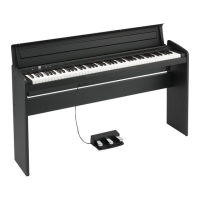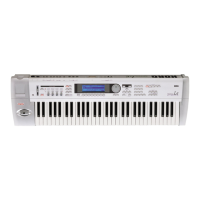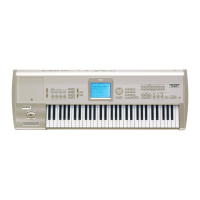Program mode
26
This parameter determines what happens when more than
one note is being held down.
Low: The lowest note will sound. Many vintage,
monophonic analog synths work this way
High: The highest note will sound.
Last: The most recently played note will sound.
Unison [On, Off]
Unison can be used in both Mono and Poly modes.
On (checked): When Unison is on, the Program uses two or
more stacked, detuned voices to create a thick sound.
Use the Number of Voices and Detune parameters to set the
number of voices and amount of detuning, and the
Thickness parameter to control the character of the
detuning.
Off (unchecked): The Program plays normally. If Unison is
Off, then all of its associated parameters are grayed out.
Number of Voices [2...6]
This controls the number of detuned voices that will be
played for each note when using Unison. It applies only
when Unison is On.
Detune [00...99 cents]
Detune is available when Unison is On.
This parameter sets the tuning spread for the Unison voices,
in cents (1/100 of a semitone). The Thickness parameter,
below, controls how the voices are distributed across the
detune amount. When Thickness is Off, the voices are
distributed evenly, centered around the basic pitch.
For instance, let’s say that the Number of voices parameter
is set to 3, Detune is set to 24, and Thickness is Off:
Voice one will be detuned down by 12 cents, voice two will
not be detuned, and voice three will be detuned up by 12
cents.
As another example, let’s say that Detune is still set to 24
and Thickness is still Off, but Number of voices is set to 4:
Voice one will still be detuned down by 12 cents, voice two
will be detuned down by 4 cents, voice three will be detuned
up by 4 cents, and voice 4 will be detuned up by 12 cents.
Thickness [Off, 01...09]
Thickness is available when Unison is On.
This parameter controls the character of the detuning for the
unison voices.
Off: Unison voices will be evenly distributed across the
Detune range, as shown above.
01–09: Unison voices will be detuned in an asymmetric way,
increasing the complexity of the detune, and changing the
way in which the different pitches beat against one another.
This creates an effect similar to vintage analog synthesizers,
in which oscillators were frequently slightly out of tune.
Higher numbers increase the effect.
1–1c: Half-Damper Control
A half-damper pedal is a special type of continuous foot
pedal, such as the Korg DS-1H. In comparison to a standard
footswitch, half-damper pedals offer more subtle control of
sustain, which can be especially useful for piano sounds.
The M3 will automatically sense when a half-damper is
connected to the rear-panel DAMPER input. For proper
operation, you will also need to calibrate the pedal, using
the Half Damper Calibration command in the Global
menu.
The off and full-on positions of the half-damper work just
like a standard footswitch. In conjunction with the Enable
Half-Damper parameter, below, intermediate positions
allow a graduated control of sustain, similar to the damper
pedal of an acoustic piano.
Enable Half-Damper [On, Off]
When this is On (checked), Half-Damper pedals, normal
sustain pedals, and MIDI CC# 64 will all modulate the Amp
EG, as described below.
When this is Off (un-checked), the pedals and MIDI CC#64
will still hold notes as usual, but will not modulate the Amp
EG.
Half-Damper Pedal and Release Time
The amount of modulation depends on whether the Amp
EG Sustain Level is set to 0 (as is the case with most acoustic
piano sounds), or set to 1 or more. The modulation is
continuous, from 1x (no change) to 55 times longer; the table
below shows a selection of representative points.
Half-Damper modulation of Amp EG Release Time
▼1–1: Menu Command
• 0: Write Program ☞p.106
• 1: Panel–SW Solo Mode On ☞p.106
• 2: Exclusive Solo ☞p.107
• 3: Copy Scene ☞p.115
• 4: Swap Scene ☞p.115
For more information, please see “Program: Menu
Command” on page 106.
Voice Detune
1
–12
2
0
3 +12
Voice Detune
1
–12
2
–4
3+4
4 +12
CC#64
Value
Multiply Amp EG Release Time by…
If Sustain = 0 If Sustain = 1 or more
01x 1x
32 2.1x 2.1x
64 3.2x
3.2x
80 5.9x
96 22.3x
127 55x

